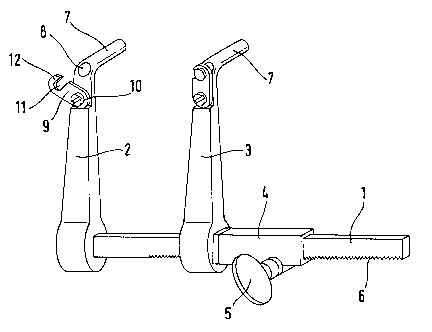Some of the information on this Web page has been provided by external sources. The Government of Canada is not responsible for the accuracy, reliability or currency of the information supplied by external sources. Users wishing to rely upon this information should consult directly with the source of the information. Content provided by external sources is not subject to official languages, privacy and accessibility requirements.
Any discrepancies in the text and image of the Claims and Abstract are due to differing posting times. Text of the Claims and Abstract are posted:
| (12) Patent Application: | (11) CA 2534103 |
|---|---|
| (54) English Title: | BONE SEPARATOR |
| (54) French Title: | ECARTEUR A OS |
| Status: | Deemed Abandoned and Beyond the Period of Reinstatement - Pending Response to Notice of Disregarded Communication |
| (51) International Patent Classification (IPC): |
|
|---|---|
| (72) Inventors : |
|
| (73) Owners : |
|
| (71) Applicants : |
|
| (74) Agent: | MARKS & CLERK |
| (74) Associate agent: | |
| (45) Issued: | |
| (86) PCT Filing Date: | 2005-04-05 |
| (87) Open to Public Inspection: | 2005-10-27 |
| Availability of licence: | N/A |
| Dedicated to the Public: | N/A |
| (25) Language of filing: | English |
| Patent Cooperation Treaty (PCT): | Yes |
|---|---|
| (86) PCT Filing Number: | PCT/EP2005/003576 |
| (87) International Publication Number: | WO 2005099589 |
| (85) National Entry: | 2006-01-27 |
| (30) Application Priority Data: | ||||||
|---|---|---|---|---|---|---|
|
The invention relates to a bone separator, comprising two tubular pin housings
(7), connected by a parallel guide and two pins (13) for connection to the
bone pieces for separation. According to the invention, a greater relative
positional security for the bone pieces for separation may be achieved,
whereby at least one pin housing (7) is provided with a stop device (12) for a
pin (13) located in the pin housing (7). The above comprises a stop finger
(12), moving tangentially to the pin housing (7), engaging in a transverse
groove (14) of the corresponding pin (13) in the stop position, which can be
embodied by a hook, mounted such as to pivot.
L'invention concerne un écarteur à os qui comprend deux logements de broche tubulaires (7), reliés entre eux par une coulisse à déplacement parallèle, ainsi que deux broches (13) à relier aux parties d'os à écarter. L'invention vise à garantir une plus grande sûreté de position l'une par rapport à l'autre aux parties d'os à écarter. A cet effet, au moins un logement de broche (7) est pourvu d'un dispositif d'arrêt (12) pour une broche (13) se trouvant dans le logement de broche (7). Ce dispositif d'arrêt comprend un doigt d'arrêt (12) qui peut être déplacé tangentiellement par rapport au logement de broche (7), qui s'engrène en position d'arrêt dans une rainure transversale (14) de la broche correspondante (13) et qui peut être formé par un crochet logé pivotant.
Note: Claims are shown in the official language in which they were submitted.
Note: Descriptions are shown in the official language in which they were submitted.

2024-08-01:As part of the Next Generation Patents (NGP) transition, the Canadian Patents Database (CPD) now contains a more detailed Event History, which replicates the Event Log of our new back-office solution.
Please note that "Inactive:" events refers to events no longer in use in our new back-office solution.
For a clearer understanding of the status of the application/patent presented on this page, the site Disclaimer , as well as the definitions for Patent , Event History , Maintenance Fee and Payment History should be consulted.
| Description | Date |
|---|---|
| Application Not Reinstated by Deadline | 2011-04-05 |
| Time Limit for Reversal Expired | 2011-04-05 |
| Inactive: Abandon-RFE+Late fee unpaid-Correspondence sent | 2010-04-06 |
| Deemed Abandoned - Failure to Respond to Maintenance Fee Notice | 2010-04-06 |
| Inactive: Correspondence - Transfer | 2009-06-30 |
| Letter Sent | 2006-11-06 |
| Inactive: Single transfer | 2006-09-14 |
| Inactive: Cover page published | 2006-03-28 |
| Inactive: Courtesy letter - Evidence | 2006-03-28 |
| Inactive: Notice - National entry - No RFE | 2006-03-24 |
| Application Received - PCT | 2006-02-22 |
| National Entry Requirements Determined Compliant | 2006-01-27 |
| Application Published (Open to Public Inspection) | 2005-10-27 |
| Abandonment Date | Reason | Reinstatement Date |
|---|---|---|
| 2010-04-06 |
The last payment was received on 2009-03-26
Note : If the full payment has not been received on or before the date indicated, a further fee may be required which may be one of the following
Please refer to the CIPO Patent Fees web page to see all current fee amounts.
| Fee Type | Anniversary Year | Due Date | Paid Date |
|---|---|---|---|
| MF (application, 2nd anniv.) - standard | 02 | 2007-04-05 | 2006-01-27 |
| Basic national fee - standard | 2006-01-27 | ||
| Registration of a document | 2006-09-14 | ||
| MF (application, 3rd anniv.) - standard | 03 | 2008-04-07 | 2008-03-26 |
| MF (application, 4th anniv.) - standard | 04 | 2009-04-06 | 2009-03-26 |
Note: Records showing the ownership history in alphabetical order.
| Current Owners on Record |
|---|
| CERVITECH, INC. |
| Past Owners on Record |
|---|
| ARNOLD KELLER |